Description and cultivation of strawberries
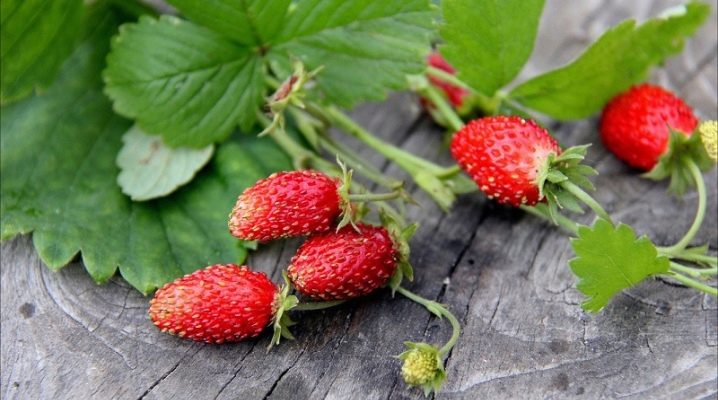
Strawberries are deservedly a favorite berry of many people. However, growing it on its own is quite difficult and requires many factors to be taken into account.
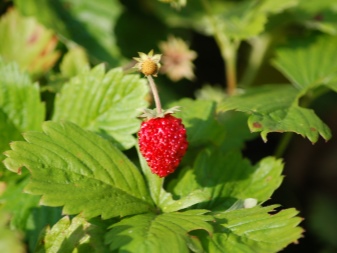
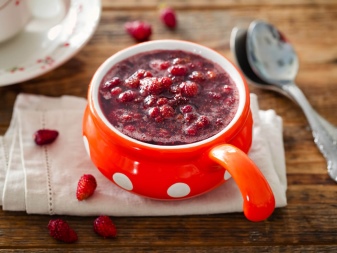
What it is?
The genus strawberry is a representative of the pink family, the order Rosaceae and the dicotyledonous class... The group of perennial herbaceous plants unites several species found in the wild, as well as bred by breeders. According to the botanical description, their trifoliate leaves have a complex shape, and the length of the stem, on which the plates are fixed, reaches 10 centimeters. The shoots of a compact bush, also called a mustache, are creeping and can take root with rosettes. The structural features of the fibrous and branched root system determine its shallow occurrence - only 20-25 centimeters.
The strawberry inflorescence looks like a shield of several bisexual flowers. Buds with white and sometimes yellowish petals are found on elongated peduncles and are usually pollinated by insects. The life form of the plant is characterized by the presence of a large number of pistils and stamens. Crop fruits are of the complex or prefabricated type.... In fact, what is eaten is an overgrown receptacle, and real fruits are grains fixed on its surface. The color of the pulp ranges from white to bright red. The flowering culture occurs approximately from late spring to mid-summer, that is, until the strawberries begin to ripen.
Strawberries live for about 7 years, although it is recommended to breed them in the same place for no more than 4 years.
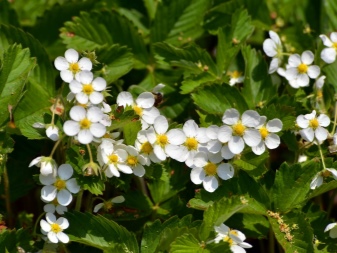
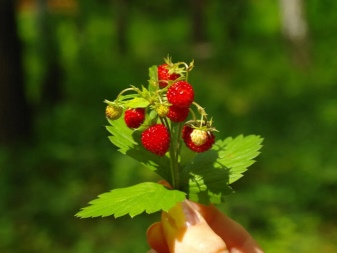
Spreading
In the wild, the crop is most often propagated with whiskers, which successfully take root in the soil. By the way, most often thanks to this method, strawberries also grow in garden plots. As for the fruits, they are naturally spread by self-scattering, water, wind and even animals.
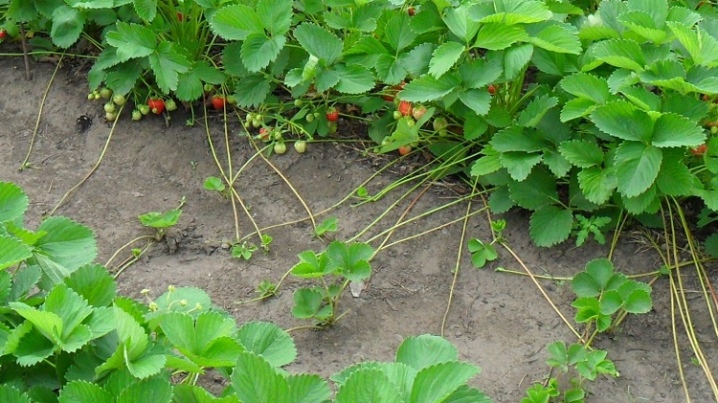
Types and varieties
The botanical genus under the Latin name Fragaria, which can be translated as "fragrant", unites approximately 20-30 species. They are all very similar to each other. Perhaps the most famous is wild strawberry or common strawberry. The bush culture grows only in the wild, stretching up to 5-20 centimeters in height. The characteristics of the species indicate that the dimensions of small berries do not exceed 2 centimeters in length. And also in the wild, green strawberries are widespread, it is also half-fruit. It is characterized by the presence of short shoots and rounded "fruits", the color of which can be pink, red or even yellowish.
Nutmeg or musk strawberries also grow in the wild, although attempts have been made to domesticate them in Europe. Bushes with large leaf blades, rather large fruits and a rich aroma are stretched 35 centimeters in height. Most plants are dioecious, that is, they form either female or male flowers. The name "garden strawberry or pineapple strawberry" hides what is usually called strawberries. This species was obtained by crossing Chilean and Virginian strawberries. Field or meadow strawberries grow in the fields. When the fragrant berry ripens in the middle of summer, the whole territory is saturated with the sweetest smell.
The strawberry genus also unites a huge number of varieties, which, according to the simplest classification, can be divided into early, mid-season, late and remontant. The first group, which is maturing already at the beginning of May, includes "Daisy Festival", "Kent" and "Elvira". From mid-season gardeners especially highlight the varieties "Lord", "Venta" and "Juan" - the harvest can be harvested from the end of June. Experts consider such varieties as "Borovitskaya" or "Vicoda" to be late varieties, and among the remontant varieties, "Brighton", "Queen Elizabeth II", "Pineapple" and "Garland" are widely known.
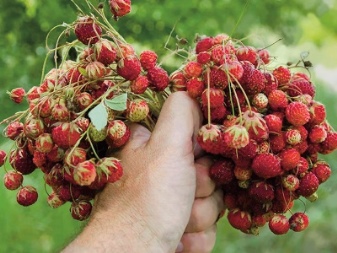
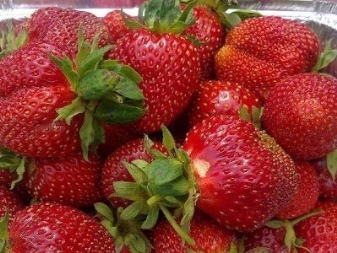
Landing
Planting crops on open ground is carried out practically in any period of the growing season, but it is most correct to do this at the beginning of spring, at the beginning of autumn, or at the end of summer. For cold and little snow regions, spring planting is more preferable, carried out after warming up the soil. In other cases, strawberry bushes are planted at the junction of summer and autumn - the chosen time allows the root system of the plant to strengthen before the onset of frost. As a result, it will be able to bear fruit the next season. Strawberries require good lighting, so you should choose a site very carefully.
You should not arrange beds where nightshades, cabbage and cucumbers used to live, as well as in those places where raspberries develop in the neighborhood. Almost any soil is suitable for berry culture, with the exception of dry sandy and swampy. Most of all, the bushes like slightly acidic sandy loam soil, as well as light loam. The earth must be saturated with nutrients, moderately humidified and with the ability to pass air. It is worth avoiding areas where there is stagnation of precipitation or melt water, as well as those characterized by a close occurrence of groundwater. The optimum acidity of the soil mixture is from 4.5 to 5.5 units.
Developed for strawberries several landing patterns, each of which has its own pros and cons... When working with individual bushes, you have to leave 45-60 free centimeters between specimens. In order for them not to get tangled with each other, the mustache is regularly removed. With a one-line planting, the bushes are planted in rows.
A gap of 15 centimeters is maintained between individual specimens, and the row spacing is 40 centimeters.
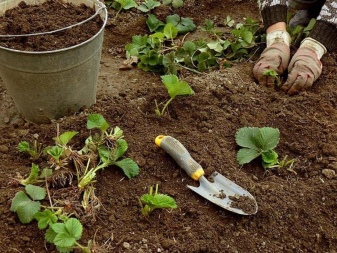

Two-line fitalso known as tape, suitable for large areas. The strawberries are arranged in two lines, the gap between which is 30 centimeters. The gap between the seedlings is 15-20 centimeters, and the row spacing reaches 70 centimeters. You can also arrange the beds in a checkerboard pattern. In this case, strawberries are planted in rows at a distance of 50 by 50 centimeters, with one row shifting relative to the other by 25 centimeters. Finally, when planting in nests, you will need to create a composition with a well-developed seedling in the center and 6 smaller pieces around it. The nests are organized in rows with a row spacing of 35-40 centimeters. The gap between individual seedlings is 6-8 centimeters, and between the nests - about 30 centimeters.
Besides the classic fit, there is an opportunity to place the culture on agrofibre... In this case, high beds are covered with a canvas, after which holes are made in it for strawberry seedlings. The culture is allowed to be placed on a mattress of rotted pea tops, under film shelters or in a vertical ridge. Before transferring seedlings to open ground, the seedlings are kept for about 5 days in a cool room. Direct landing is best done in the evening. The seedlings are freed from all leaves, except for a couple of internal ones - this will allow the plant to direct all its forces to the development of the root system. Before immersion in the hole, the roots are dipped in a mixture of clay and peat, and then straightened along their entire length.It is most successful to make a small mound in the hole, on top of which to place the bush.
We must not forget that the heart should rise slightly above the surface, and the root collar should be completely in the ground... When the strawberries take their place, the soil around will need to be compacted, preventing voids from occurring, and then abundant irrigation should be organized. It should be mentioned that purchased seedlings are often "famous" for twisted roots. Before planting, they must be straightened, cleaned of rotten processes and, if necessary, shortened.
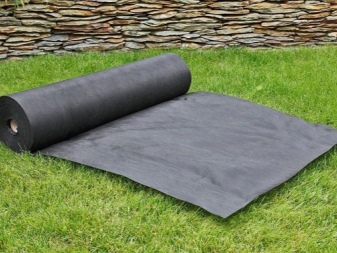
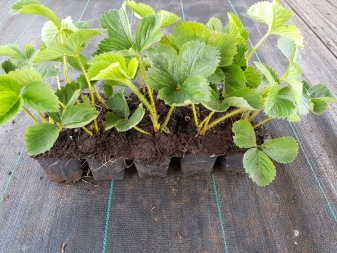
Care
Proper care of strawberry plantings is the key to the successful development of culture.
Watering
Irrigation of strawberry bushes is required to be organized regular and sufficient, especially when it comes to its garden variety. The frequency of the procedure may vary depending on weather and soil conditions. For example, if clay is present in the soil, then it needs less moisture. Before flowering, the plant is allowed to be sprinkled, but then moisture must always be directed to the root. Watering is carried out on average every 10-12 days, but in the heat this figure increases significantly. Water should be used that has settled and warmed up naturally in the sun.
Each square meter of planting requires about 10-12 liters of liquid, which should saturate the soil by 20-25 centimeters. It is customary to arrange irrigation either in the early morning or in the late afternoon.
When the crop begins to bear fruit, the frequency of watering will have to be reduced so that the fruit pulp does not turn out to be watery.
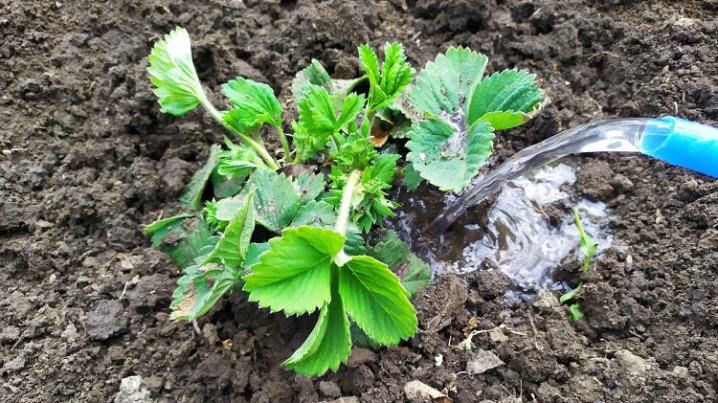
Top dressing
It is customary to apply fertilizer for strawberries for the first time when young leaf blades appear on the bush. A tablespoon of liquid sodium humate or the same amount of urea is diluted with 10 liters of water. For each bush, 0.5 liters of the resulting mixture will have to be used. The use of diluted mullein or chicken manure will be appropriate. For foliar feeding at this stage, a combination of 2 grams of potassium permanganate, the same amount of boric acid and ammonium molybdate, diluted in a bucket of water, is suitable.
The next feeding should be arranged before the flowering of the culture. Gardeners recommend combining a tablespoon of Agricola Aqua, the same amount of Effecton Ya, a teaspoon of potassium sulfate and 10 liters of water. After 0.5 liters of the mixture is poured under each bush, it will be possible to arrange foliar spraying. Finally, the final fertilization is done after picking the berries. A glass of ash, a tablespoon of nitrophoska and the same amount of "Effecton" are diluted in 10 liters of water, after which 1 liter is poured under each specimen of strawberries.
In principle, an alternative to all of the above mixtures can be purchased complex preparations intended for strawberries.
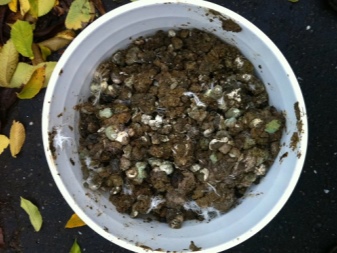
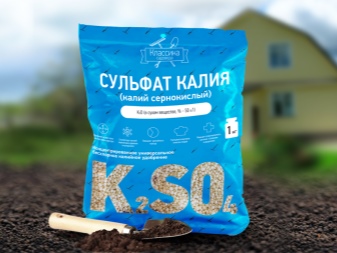
Pruning
It will be enough to prune strawberries 2 times a year: before flowering and after harvesting. The procedure will be arranged early in the morning or late in the evening, accompanied by insect treatment. The mustache should be removed with special tools, leaving a stalk equal to 10 centimeters.
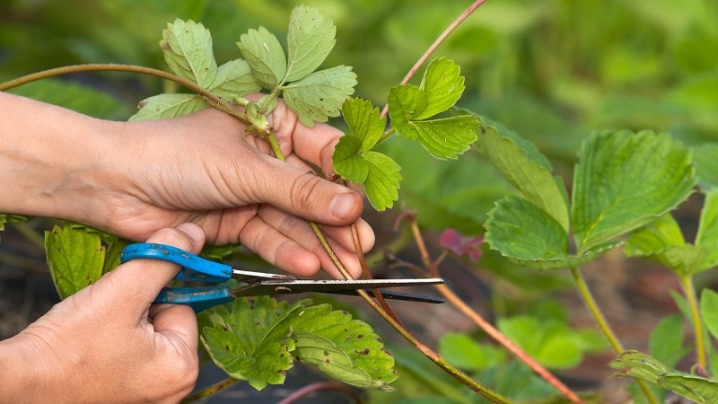
Transfer
It is allowed to replant strawberry varieties only when the plant reaches the age of 4-5 years. If we are talking about remontant varieties, then the procedure is possible every 2 years. The optimal time for the procedure is September, and you should act in the same way as during the initial planting.... When the bushes find themselves in a new habitat, the aisles will have to be covered with mulch.
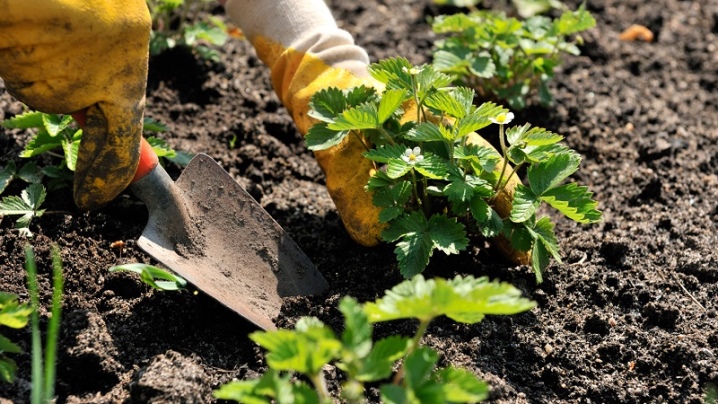
Reproduction
The main vegetative organ of strawberries is the whiskers, that is, the shoots crawling along the ground. Reproduction with their help is very simple: it is enough to choose a healthy socket aged 1 or 2 years, slightly press it into the ground, and sprinkle it with loose earth, making sure that the heart is not covered.When the mustache takes root around September, all that remains is to transplant it to a permanent place of growth. For varieties of berries that do not have a mustache, the seed method is used, as well as the division of the bush.
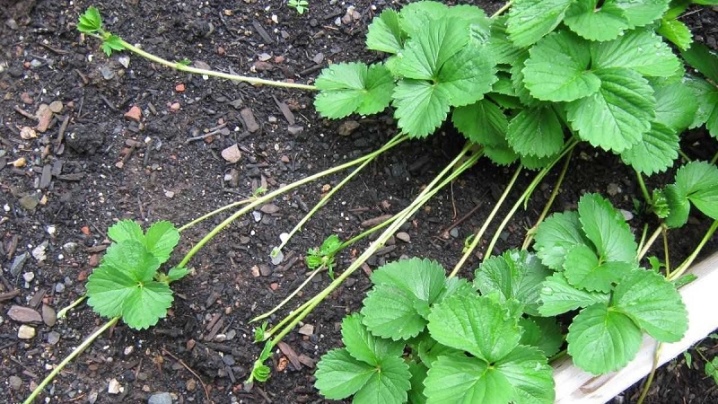
Diseases and pests
Strawberries of different species and varieties are characterized by the same diseases. It is about fungal fusarium wilting, affecting not only the bush itself, but also its roots, verticillary wilting, leading to the death of the plant, late blight and late blight rot. Gray mold infestation occurs due to the thickening of plantings and causes irreparable damage to berry "fruits". Powdery mildew, characterized by the appearance of a whitish coating, affects all parts of the plant, with the exception of the roots. Of insects, berry crops are most often exposed to weevils, ticks and nematodes.
In order not to face any of the above problems, gardeners pay enough attention to prevention, spraying plantings with copper-containing preparations, timely removing obsolete foliage and mulch, and also not forgetting about the use of insecticides.

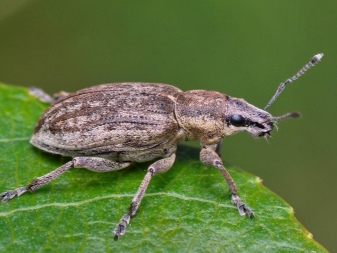













The comment was sent successfully.